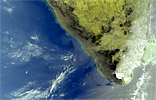

South-West coast of India
10. February 2005,
orbit: 15418

Chlorophyll concentration

Aerosol optical thickness at 550nm

Depth where 90% of the light is absorbed at wavelength where this value is maximal
Click on the small images above to get the full resolution image (appr. 5÷6MB)

